A week in the shop, and a week in Nantes
Published 20 Aug 2018
Return of the weeknotes, though I fear the next couple of weeks will be sparse guitar work wise due to August being a month of travel. The week before last I had family visiting for much of the week that kept me busy, and then last week I was on actual vacation in Nantes, France, enjoying a combination of the annual arts festival and just switching off and indulging in things like cooking local produce from the market in our rented apartment. Between these events I failed to write up what I did before all this week, so here it is below.
This coming week I’ll be mostly doing paid software work whilst I’m at home, and then I’m in Helsinki for a few days (tagging along with my other half who is out there for work), before heading to EMFCamp, a weekend long hacker festival where I’ll be talking about how I got started in a new domain again. If you happen to be at EMFCamp do say hello!
Anyway, what is happened last couple of weeks, and normal service should resume in September.
I started the previous week with two guitars hung up and ready to move forward: one made from parts the CNC router had tried to destroy and I’d patched, and the actual bits from the first of the commissioned offsets (both of which need names). What unites them both at this stage is that they need fretboards next.
In the past I’ve radiused fretboards by hand using a radiused sanding block, but you have to be very careful not to introduce any bias as you do so: it’s far too easy to take a little off one side more than the other at the diagonally opposite corners, due to how your arm moves relative to your body even when you think you’re pushing straight. The common solution to this is to use a jig to make sure you don’t go down too much at any point, but I wondered if perhaps I could use the CNC router to radius the fretboard roughly, and then just use sanding block to remove the machine marks rather than the bulk of the wood.
Whilst it sounds simple enough, the worry I had is that, unlike most people, I use a laser cutter to etch guide lines for my saw to cut the frets. Being an optical device a laser cutter has an ideal distance above the cutting surface to ensure it is properly focussed: if I radius first then my cutting surface will no longer be flat, and thus I can’t guarantee it’ll be in focus at the edges. This might mean the grooves I etch aren’t deep enough to sit the saw in to get it started.
To test this I got a bit of scrap wood and used my radius block on it shape it like a fretboard, and then I used the laser cutter at various powers to etch the 0.5mm slot I’d normally use to create my saw blade guide. You can see the results here:
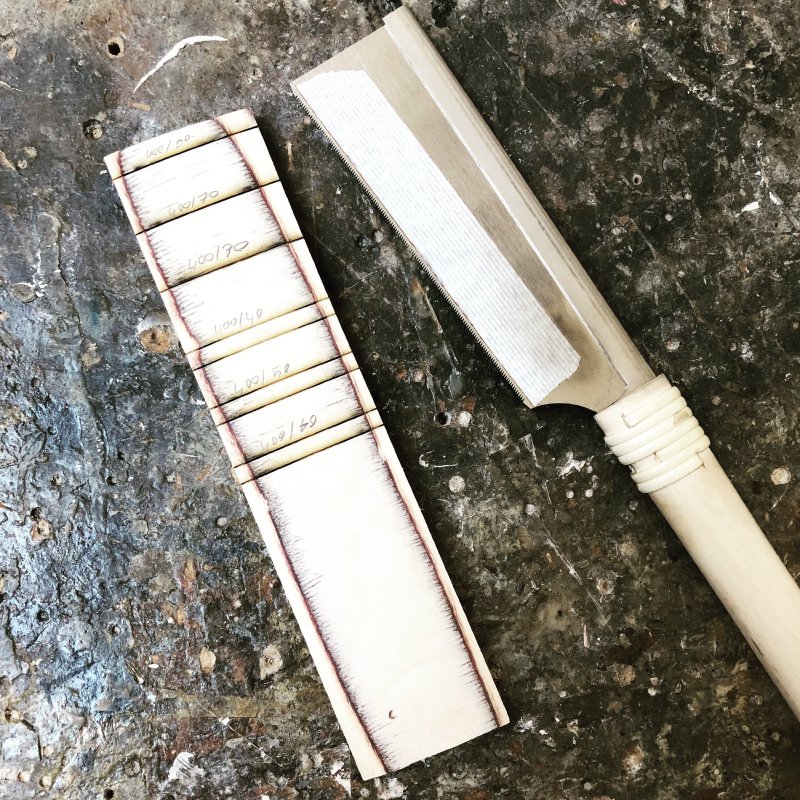
First thing to note: because I used ply wood and just did a quick job of the radiusing you can see the contour lines show the biasing effect I’m talking about. As I’m right handed you can see despite thinking I was sanding straight I’m actually going sort of from bottom right to top left slightly. This is what I’m trying to avoid with all this talk of jigs or CNCing.
Next thing to note: the radiusing had no notable effect on the slot I etch, proving my fears were unfounded. The fall off at either side is only around 1.5 mm, and that isn’t enough to cause the laser to lose focus. I did however find that I had to be much more careful when cutting the slots with the saw. Compared to cutting the slots before radiusing the board it was much easier to slip out of the grove, as you have a smaller contact point with the wood when sawing.
Overall it worked a charm though, albeit with the caveat you need to be extra slow when sawing the slots. The frets you see in the above picture are held firm without glue, so that’s a green light on this approach in general.
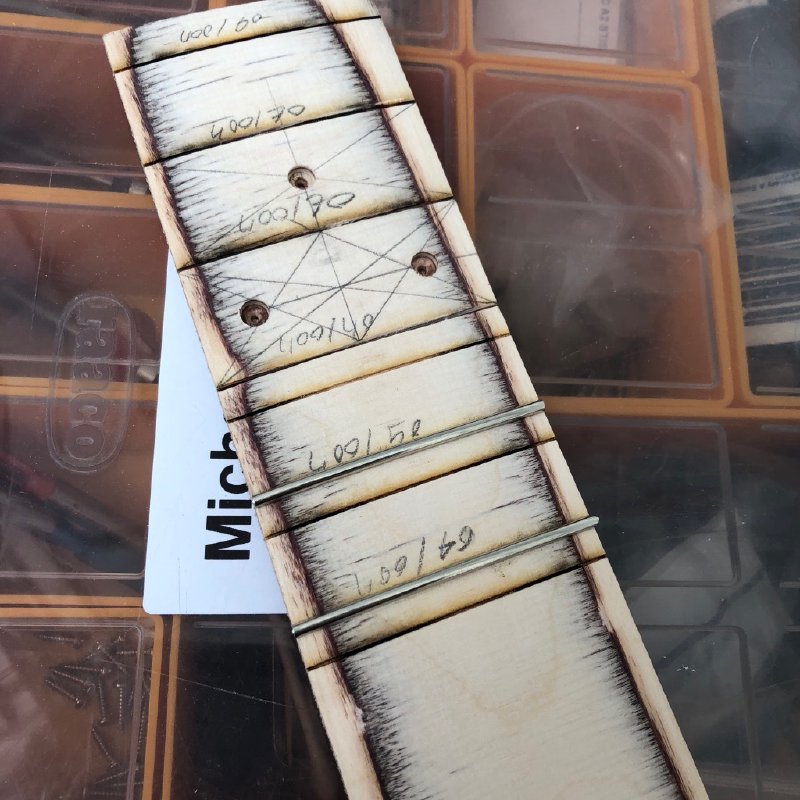
Next up then is to get the CNC router to make a fretboard with a radius, or more specifically to get Fusion 360 to generate the toolpaths to do so. This turned out to be much harder than I had anticipated, and I lost easily a day of work just trying to tweak toolpaths to ensure Fusion didn’t do something I didn’t want.
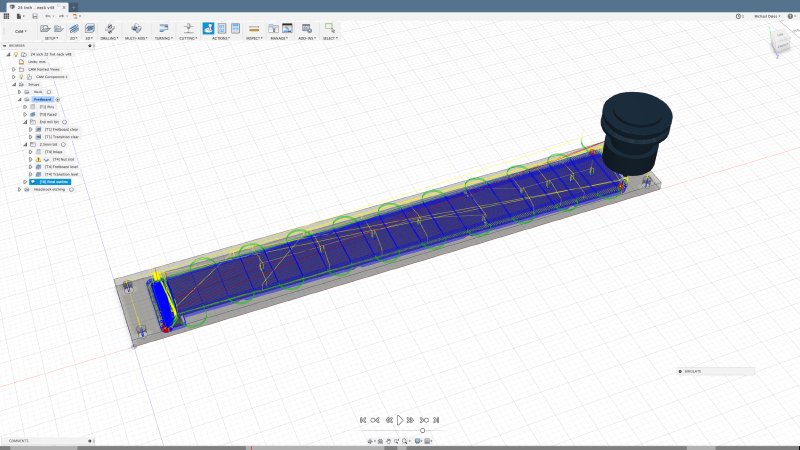
Fusion 360 in general is more aggressive with its tool moves than I like for guitar work: it’ll happily assume it can cut through 10mm of wood in a single pass, whereas typically I want it to move more slowly to ensure a nice finish. It took me quite a while to get Fusion not to do occasional plunges through the material, which whilst not incorrect would have not left me with the finish I wanted. It was a nice reminder that whilst I’ve used Fusion quite heavily for the last year it’s mostly within a set of regular operations, and outside that I’m still a bit of a newbie.
Once I had a toolpath, I then set out to make a test fretboard. I found a old maple fretboard blank I had in stock, and set about cutting it out, trying to fit this in at the last moment before I went on vacation. At this point I also had family visiting, and my brother and brother-in-law asked to watch, so I set them up with PPE and got started.
Initially things went well, but in the end due to a combination of being tired and feeling watched I made a mistake, resulting in my fretboard blank being ruined. As is always the way with a new set of toolpaths, I end up tweaking them on the fly as I learn more about what each pass is doing. On this occasion I realised that the bulk clearing paths for the fretboard didn’t account for the initial levelling paths I’d created to get the blank down from 9mm to the 6mm required. So, rather than watching the CNC router cut air for a good 10 minutes, I aborted that part of the run and went back to Fusion 360, tweaked the tool paths to start further down and set things going again. Unfortunately, I failed to double check what the updated toolpaths would do, and failed to spot that I’d ended up generating toolpaths that cut behind the headstock transition and through the fretboard itself. Doh.

In the above image you can see on the left the headstock transition is a weird island on its own rather than a ramp down at the end of the fretboard. At least this was my mistake rather than a failure of the CNC router: me being wrong is generally easier to fix than the CNC router being wrong. But all the same, as this was the last free evening before heading to France, I was quite frustrated not to have made at least one fretboard before I went away. As ever, this just reinforces the measure, measure, cut mantra: due to being tired and the pressures of being watched I’d not double checked my toolpaths, so I only have myself to blame.
I quickly ordered a couple of more blanks before going away, so I’ll see if I can sneak in time this week to do another test cut of my fretboard design.
However, in general we had a fun week with my family around. I introduced my nieces, Leah and Sarah, to 3D printing, letting them pick an item from thingiverse (they went for a Pokemon) and printing it out there and then. I think it’s one thing to hear of 3D printers, but it’s another thing to actually see a thing you picked appear out of nowhere.
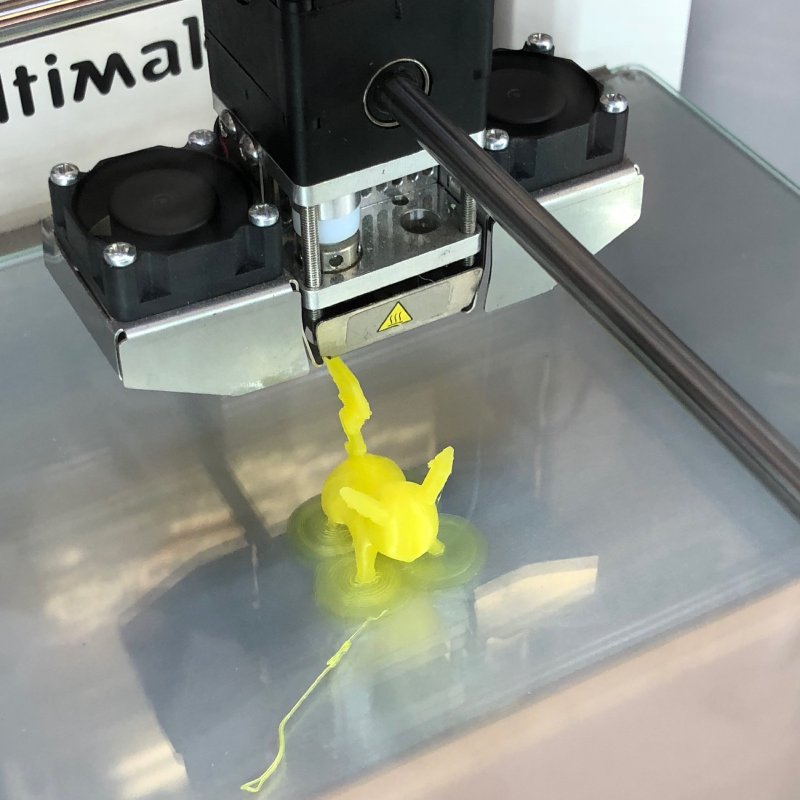
With luck that’ll inspire them to make things themselves one day.
I also took an afternoon out to take my brother Tristan and Sarah to a rehearsal studio for an afternoon where we had quite a fun jam session. Tristan is a very talented guitarist, playing with IKARI, and ordered and plays the second guitar I ever made, and Sarah has been taking guitar lessons for quite a while now, so it seemed a reasonable idea to collect up the guitars I had and my amp and find somewhere we could make some noise.
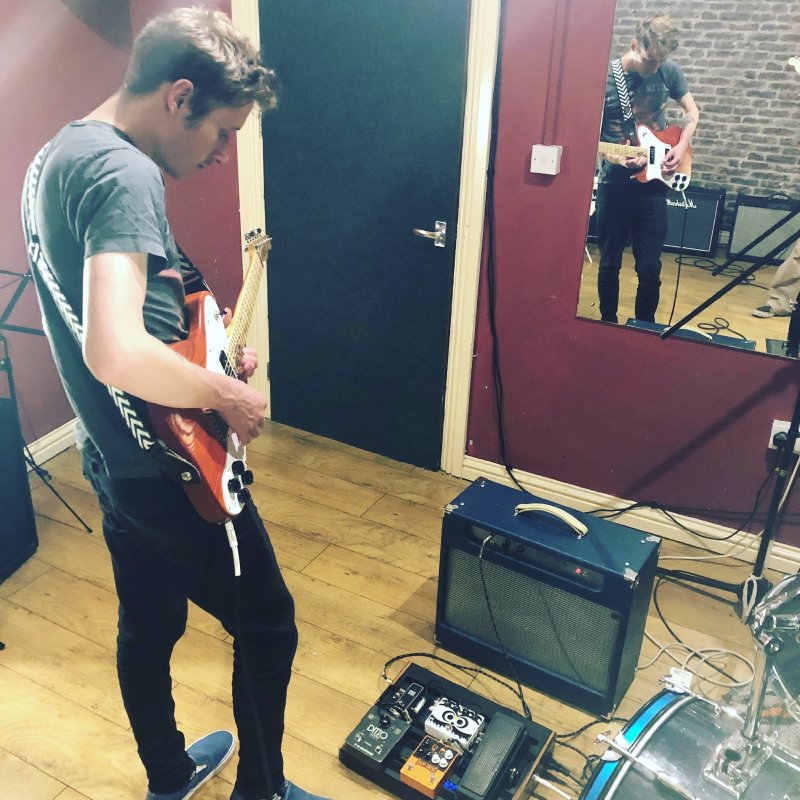
Tris hadn’t yet had a go on my amplifier, so he gave that a going over. and seemed to like it for the cleans on his IKARI parts (I have to confess, I wasn’t aware he did cleans, but you learn something every day ;).
It was a bit last minute, so I failed to secure a left handed guitar for Sarah in time, but she did a valiant attempt with the right handed guitars we took along. In addition to playing some of the stuff she already knew, I managed to teach her the blues scales enough that we could have a simple jam along together.
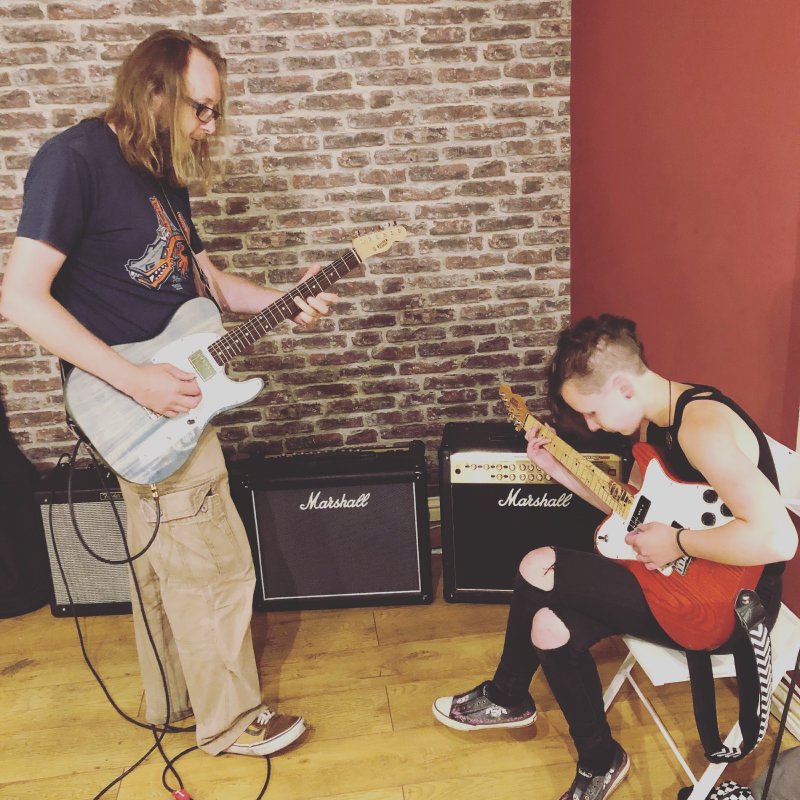
Tris also taught me the rhythm part to Ocean Waves and we jammed that together. A great afternoon of fun just playing guitars with family, and a reminder of why the guitars are worth all the effort!
Much to my surprise, although I took the vacation time to totally switch off, there was a surprising amount of cool guitar stuff at the art festival. First was Fluides, by Céleste Boursier-Mougenot, where in a netted space filled with dozens of small birds that would come to rest upon a number of face up mounted guitars, which were wired through delays and reverbs to amplifiers. Each time a bird would land on a guitar or shuffle along the neck you’d get a lovely ambience sound piece.
In Daniel Firman’s exhibition, Outside, one of the pieces was called Drone, which featured three telecasters being spun at speed from their headstocks, with weighted spindles that would occasionally strum them. The guitars were each tuned to a different range, so the effect was somewhere between a didgeridoo and Mongolian throat singing.
Finally, I was surprised to find out in the rural areas south east of Nantes a giant Les Paul emerging from a round about:
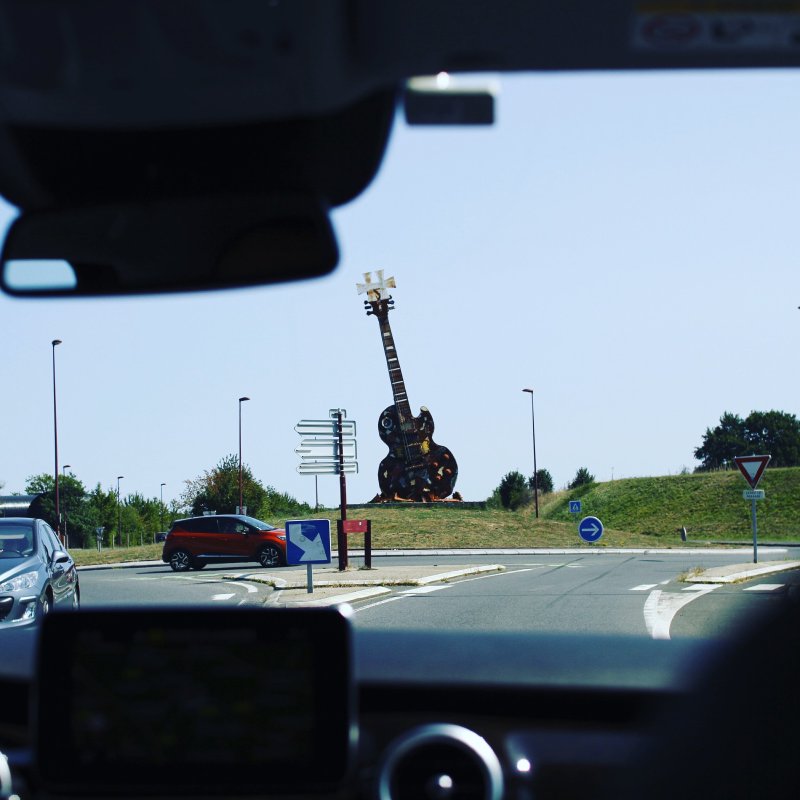
It turns out that Hellfest, a massive annual heavy metal festival, takes please each year in the middle of the Loire vineyards. All the villages in this area compete on decorated roundabouts - I assume this one must be one of the more unusual ones!